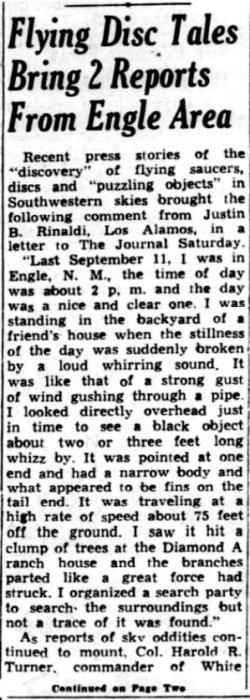The article below was published in the newspaper The Albuquerque Journal, Albuquerque, New Mexico, USA, pages 1,2, on June 29, 1947.

|
Recent press stories of the "discovery" of flying saucers, discs, and "puzzling objects" in Southwestern skies brought the following comment from Justin B. Rinaldi, Los Alamos, in a letter to The Journal Saturday.
"Last September 11, I was in Engle, N. M., the time of day was about 2 p. m. and the day was a nice and clear one. I was standing in the backyard of a friend's house when the stillness of the day was broken by a loud whirring sound. It was like that of a strong gust of wind gushing through a pipe. I looked directly overhead just in time to see a black object about two or three feet long whizz by. It was pointed at one end and had a narrow body and what appeared to be fins on the tail end. It was traveling at a high rate of speed about 75 feet off the ground. I saw it hit a clump of trees at the Diamond A ranch house and the branches parted as if a great force had struck. I organized a search party to search the surroundings but not a trace of it was found."
As reports of sky oddities continued to mount, Col. Harold R. Turner, commander of White
Continued on Page Two

|
Sands Proving Grounds, said according to the Associated Press that the puzzling objects were apparently meteors that "are coming closer to the surface of the earth and appear much larger."
Turner revised a guess that the shining objects might be an illusion created by hot circular exhausts of jet planes upon a check of the two new observations. The officer gave this report:
Captain Dvyan of the Alamogordo air base, in a private plane near Engel at about 8000 feet altitude, looked down and saw "a ball of fire with a blue fiery tail" about 2000 feet below him. It disintegrated as he watched, Dvyan said he was sure it was a meteorite.
W. C. Dodds, train inspector, saw a flame "high in the sky" at 9:50 a.m. yesterday about half a mile south of Hope. Capt. E. B. Detchmendy of the ordnance department at White Sands saw it too, from the St. Augustine pass.
Reflections of the sun's rays, Col. Turner said, could give a meteorite the appearance of a shiny flying disc which might appear to be quite near and traveling slowly, whereas it actually is many miles away and traveling at more than the speed of sound.
Another report of the shiny discs came today from El Paso where Dr. G. Oliver Dickson, optometrist, said he saw the object Sunday near the outskirts of El Paso. Dickson said the object looked like a blimp, was traveling over a mountain top, and although it appeared bright and shiny, it did not reflect the sun's rays.
From his 15-second observance, he estimated its speed at 150 miles an hour and its size as about 40 feet across and five feet thick.